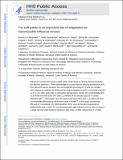The soft palate is an important site of adaptation for transmissible influenza viruses
Author(s)
Lakdawala, Seema S.; Jayaraman, Akila; Halpin, Rebecca A.; Lamirande, Elaine W.; Shih, Angela R.; Stockwell, Timothy B.; Lin, Xudong; Simenauer, Ari; Hanson, Christopher T.; Vogel, Leatrice; Paskel, Myeisha; Minai, Mahnaz; Moore, Ian; Orandle, Marlene; Das, Suman R.; Wentworth, David E.; Sasisekharan, Ram; Subbarao, Kanta; ... Show more Show less
DownloadThe soft palate.pdf (4.230Mb)
OPEN_ACCESS_POLICY
Open Access Policy
Creative Commons Attribution-Noncommercial-Share Alike
Terms of use
Metadata
Show full item recordAbstract
Influenza A viruses pose a major public health threat by causing seasonal epidemics and sporadic pandemics. Their epidemiological success relies on airborne transmission from person to person; however, the viral properties governing airborne transmission of influenza A viruses are complex. Influenza A virus infection is mediated via binding of the viral haemagglutinin (HA) to terminally attached α2,3 or α2,6 sialic acids on cell surface glycoproteins. Human influenza A viruses preferentially bind α2,6-linked sialic acids whereas avian influenza A viruses bind α2,3-linked sialic acids on complex glycans on airway epithelial cells. Historically, influenza A viruses with preferential association with α2,3-linked sialic acids have not been transmitted efficiently by the airborne route in ferrets. Here we observe efficient airborne transmission of a 2009 pandemic H1N1 (H1N1pdm) virus (A/California/07/2009) engineered to preferentially bind α2,3-linked sialic acids. Airborne transmission was associated with rapid selection of virus with a change at a single HA site that conferred binding to long-chain α2,6-linked sialic acids, without loss of α2,3-linked sialic acid binding. The transmissible virus emerged in experimentally infected ferrets within 24 hours after infection and was remarkably enriched in the soft palate, where long-chain α2,6-linked sialic acids predominate on the nasopharyngeal surface. Notably, presence of long-chain α2,6-linked sialic acids is conserved in ferret, pig and human soft palate. Using a loss-of-function approach with this one virus, we demonstrate that the ferret soft palate, a tissue not normally sampled in animal models of influenza, rapidly selects for transmissible influenza A viruses with human receptor (α2,6-linked sialic acids) preference.
Date issued
2015-09Department
Harvard University--MIT Division of Health Sciences and Technology; Massachusetts Institute of Technology. Department of Biological Engineering; Koch Institute for Integrative Cancer Research at MITJournal
Nature
Publisher
Nature Publishing Group
Citation
Lakdawala, Seema S. et al. “The Soft Palate Is an Important Site of Adaptation for Transmissible Influenza Viruses.” Nature 526.7571 (2015): 122–125.
Version: Author's final manuscript
ISSN
0028-0836
1476-4687